Updating Absolute Radiometric Characteristics for KOMPSAT-3 and KOMPSAT-3A Multispectral Imaging Sensors Using Well-Characterized Pseudo-Invariant Tarps and Microtops II
Abstract
1. Introduction
2. Materials and Methods
3. Results
3.1. Laboratory-Based BRDF Measurements of Tarps
3.2. Hyperspectral Reflectances of Tarps Using Dual ASD FieldSpec® System
3.3. Microtops II® Sunphotometer and Ozonometer Measurement of Atmospheric Conditions
3.4. Determination of DN to Radiance Coefficients for KOMPSAT-3 and -3A
4. Discussion
5. Conclusions
Author Contributions
Acknowledgments
Conflicts of Interest
References
- Chander, G.; Markham, B. Revised Landsat-5 TM radiometric calibration procedures and postcalibration dynamic ranges. IEEE Trans. Geosci. Remote Sens. 2003, 41, 2674–2677. [Google Scholar] [CrossRef]
- Franz, B.A.; Bailey, S.W.; Werdell, P.J.; McClain, C.R. Sensor-independent approach to the vicarious calibration of satellite ocean color radiometry. Appl. Opt. 2007, 46, 5068–5082. [Google Scholar] [CrossRef] [PubMed]
- Thome, K.J.; Arai, K.; Tsuchida, S.; Biggar, S.F. Vicarious Calibration of ASTER via the Reflectance-Based Approach. IEEE Trans. Geosci. Remote Sens. 2008, 46, 3285–3295. [Google Scholar] [CrossRef]
- Liu, C.C.; Kamei, A.; Hsu, K.H.; Tsuchida, S.; Huang, H.M.; Kato, S.; Nakamura, R.; Wu, A.M. Vicarious Calibration of the Formosat-2 Remote Sensing Instrument. IEEE Trans. Geosci. Remote Sens. 2010, 48, 2162–2169. [Google Scholar] [CrossRef]
- Rao, C.R.N.; Chen, J.; Sullivan, J.T.; Zhang, N. Post-launch calibration of meteorological satellite sensors. In Advances in Space Research; Tsuchiya, K., Ed.; Elsevier: Amsterdam, The Netherlands, 1999; Volume 23, pp. 1357–1365. ISBN 0273-1177. [Google Scholar]
- Thome, K.J. Absolute radiometric calibration of Landsat 7 ETM+ using the reflectance-based method. Remote Sens. Environ. 2001, 78, 27–38. [Google Scholar] [CrossRef]
- Markham, B.L.; Helder, D.L. Forty-year calibrated record of earth-reflected radiance from Landsat: A review. Remote Sens. Environ. 2012, 122, 30–40. [Google Scholar] [CrossRef]
- Dinguirard, M.; Slater, P.N. Calibration of space-multispectral imaging sensors: A review. Remote Sens. Environ. 1999, 68, 194–205. [Google Scholar] [CrossRef]
- Ham, S.H.; Sohn, B.J. Assessment of the calibration performance of satellite visible channels using cloud targets: Application to Meteosat-8/9 and MTSAT-1R. Atmos. Chem. Phys. 2010, 10, 11131–11149. [Google Scholar] [CrossRef]
- Koepke, P. Vicarious satellite calibration in the solar spectral range by means of calculated radiances and its application to Meteosat. Appl. Opt. 1982, 21, 2845–2854. [Google Scholar] [CrossRef] [PubMed]
- Yeom, J.M.; Hwang, J.; Jung, J.H.; Lee, K.H.; Lee, C.S. Initial Radiometric Characteristics of KOMPSAT-3A Multispectral Imagery Using the 6S Radiative Transfer Model, Well-Known Radiometric Tarps, and MFRSR Measurements. Remote Sens. 2017, 9, 130. [Google Scholar] [CrossRef]
- Chander, G.; Markham, B.L.; Helder, D.L. Summary of current radiometric calibration coefficients for Landsat MSS, TM, ETM+, and EO-1 ALI sensors. Remote Sens. Environ. 2009, 113, 893–903. [Google Scholar] [CrossRef]
- Xiong, X.X.; Barnes, W. An overview of MODIS radiometric calibration and characterization. Atmos. Sci. 2006, 23, 69–79. [Google Scholar] [CrossRef]
- Ono, A.; Sakuma, F.; Arai, K.; Yamaguchi, Y.; Fujisada, H.; Slater, P.N.; Thome, K.J.; Palluconi, F.D.; Kieffer, H.H. Preflight and in-flight calibration plan for ASTER. J. Atmos. Ocean. Technol. 1996, 13, 321–335. [Google Scholar] [CrossRef]
- Obata, K.; Tsuchida, S.; Iwao, K. Inter-Band Radiometric Comparison and Calibration of ASTER Visible and Near-Infrared Bands. Remote Sens. 2015, 7, 15140–15160. [Google Scholar] [CrossRef]
- Kamei, A.; Nakamura, K.; Yamamoto, H.; Nakamura, R.; Tsuchida, S.; Yamamoto, N.; Sekiguchi, S.; Kato, S.; Liu, C.C.; Hsu, K.H.; et al. Cross Calibration of Formosat-2 Remote Sensing Instrument (RSI) Using Terra Advanced Spaceborne Thermal Emission and Reflection Radiometer (ASTER). IEEE Trans. Geosci. Remote Sens. 2012, 50, 4821–4831. [Google Scholar] [CrossRef]
- Obata, K.; Tsuchida, S.; Yamamoto, H.; Thome, K. Cross-Calibration between ASTER and MODIS Visible to Near-Infrared Bands for Improvement of ASTER Radiometric Calibration. Sensors 2017, 17, 1793. [Google Scholar] [CrossRef] [PubMed]
- Helder, D.; Thome, K.J.; Mishra, N.; Chander, G.; Xiong, X.X.; Angal, A.; Choi, T. Absolute Radiometric Calibration of Landsat Using a Pseudo Invariant Calibration Site. IEEE Trans. Geosci. Remote Sens. 2013, 51, 1360–1369. [Google Scholar] [CrossRef]
- Hovis, W.A.; Knoll, J.S.; Smith, G.R. Aircraft measurements for calibration of an orbiting spacecraft sensor. Appl. Opt. 1985, 24, 407–410. [Google Scholar] [CrossRef] [PubMed]
- Vogelmann, J.E.; Helder, D.; Morfitt, R.; Choate, M.J.; Merchant, J.W.; Bulley, H. Effects of Landsat 5 thematic mapper and Landsat 7 enhanced thematic mapper plus radiometric and geometric calibrations and corrections on landscape characterization. Remote Sens. Environ. 2001, 78, 55–70. [Google Scholar] [CrossRef]
- Yeom, J.M.; Hwang, J.; Jin, C.G.; Lee, D.H.; Han, K.S. Radiometric Characteristics of KOMPSAT-3 Multispectral Images Using the Spectra of Well-Known Surface Tarps. IEEE Trans. Geosci. Remote Sens. 2016, 54, 5914–5924. [Google Scholar] [CrossRef]
- Chander, G.; Xiong, X.X.; Choi, T.Y.; Angal, A. Monitoring on-orbit calibration stability of the Terra MODIS and Landsat 7 ETM+ sensors using pseudo-invariant test sites. Remote Sens. Environ. 2010, 114, 925–939. [Google Scholar] [CrossRef]
- Erdenebaatar, N.; Kim, J.; Kim, T. Analysis of Geometric and Spatial Image Quality of KOMPSAT-3A Imagery in Comparison. Korea J. Remote Sens. 2017, 33, 1–13. [Google Scholar] [CrossRef][Green Version]
- Kim, J.; Jin, C.; Choi, C.; Ahn, H. Radiometric characterization and validation for the KOMPSAT-3 sensor. Remote Sens. Lett. 2015, 6, 529–538. [Google Scholar] [CrossRef]
- Jeong, J.; Kim, J.; Kim, T.; Rhee, S. Evaluation of the performance of KOMPSAT-3 stereo images in terms of positioning and the generation of digital surface models. Remote Sens. Lett. 2016, 7, 955–964. [Google Scholar] [CrossRef]
- Seo, D.; Oh, J.; Lee, C.; Lee, D.; Choi, H. Geometric Calibration and Validation of Kompsat-3A AEISS-A Camera. Sensors 2016, 16, 1776. [Google Scholar] [CrossRef] [PubMed]
- Lee, K.; Kim, E.; Kim, Y. Orthorectification of KOMPSAT Optical Images Using Various Ground Reference Data and Accuracy Assessment. J. Sens. 2017, 2017, 1–14. [Google Scholar] [CrossRef]
- Slater, P.N.; Biggar, S.F.; Thome, K.J.; Gellman, D.I.; Spyak, P.R. Vicarious radiometric calibrations of EOS sensors. J. Atmos. Ocean. Technol. 1996, 13, 349–359. [Google Scholar] [CrossRef]
- Yang, A.; Zhong, B.; Wu, S.; Liu, Q. Evaluation on Radiometric Capability of Chinese Optical Satellite Sensors. Sensors 2017, 17, 204. [Google Scholar] [CrossRef] [PubMed]
- Lee, H.; Hand, D.; Seo, D.; Park, B.; Ahn, K. Detection of theUnified Control Points for RPCAdjustment of KOMPSAT-3 Satellite Image. Korea J. Remote Sens. 2014, 30, 829–837. [Google Scholar] [CrossRef]
- Nandy, P.; Thome, K.; Biggar, S. Characterization and field use of a CCD camera system for retrieval of bidirectional reflectance distribution function. J. Geophys. Res.-Atmos. 2001, 106, 11957–11966. [Google Scholar] [CrossRef]
- Vermote, E.F.; Tanre, D.; Deuze, J.L.; Herman, M.; Morcrette, J.J. Second simulation of the satellite signal in the solar spectrum, 6s: An overview. IEEE Trans. Geosci. Remote Sens. 1997, 35, 675–686. [Google Scholar] [CrossRef]
- Kotchenova, S.Y.; Vermote, E.F.; Matarrese, R.; Klemm, F.J. Validation of a vector version of the 6S radiative transfer code for atmospheric correction of satellite data. Part I: Path radiance. Appl. Opt. 2006, 45, 6762–6774. [Google Scholar] [CrossRef] [PubMed]
- Seidel, F.C.; Kokhanovsky, A.A.; Schaepman, M.E. Fast and simple model for atmospheric radiative transfer. Atmos. Meas. Tech. 2010, 3, 1129–1141. [Google Scholar] [CrossRef]
- Vermote, E.F.; Kotchenova, S. Atmospheric correction for the monitoring of land surfaces. J. Geophys. Res. 2008, 113, D23S90. [Google Scholar] [CrossRef]
- Von Hoyningen-Huene, W.; Yoon, J.; Vountas, M.; Istomina, L.G.; Rohen, G.; Dinter, T.; Kokhanovsky, A.A.; Burrows, J.P. Retrieval of spectral aerosol optical thickness over land using ocean color sensors MERIS and SeaWiFS. Atmos. Meas. Tech. 2011, 4, 151–171. [Google Scholar] [CrossRef]
- Wu, A.; Li, Z.; Cihlar, J. Effects of land cover type and greenness on advanced very high resolution radiometer bidirectional reflectances: Analysis and removal. J. Geophys. Res. 1995, 100, 9179–9192. [Google Scholar] [CrossRef]
- Georgiev, G.T.; Butler, J.J. Laboratory-based bidirectional reflectance distribution functions of radiometric tarps. Appl. Opt. 2008, 47, 3313–3323. [Google Scholar] [CrossRef] [PubMed]
- Feingersh, T.; Dorigo, W.; Richter, R.; Dor, E.B. A new model-driven correction factor for BRDF effects in HRS data. In Proceedings of the EARSel Workshop, Warsaw, Poland, 27–30 April 2005. [Google Scholar]
- Hwang, J.S. Absolute measurement of hyperspectral and angular reflection. Appl. Opt. 2014, 53, 6216–6221. [Google Scholar] [CrossRef] [PubMed]
- Teillet, P.M.; Fedosejevs, G.; Gauthier, R.P.; O’Neill, N.T.; Thome, K.J.; Biggar, S.F.; Ripley, H.; Meygret, A. A generalized approach to the vicarious calibration of multiple earth observation sensors using hyperspectral data. Remote Sens. Environ. 2001, 77, 304–327. [Google Scholar] [CrossRef]
- De Vries, C.; Danaher, T.; Denham, R.; Scarth, P.; Phinn, S. An operational radiometric calibration procedure for the landsat sensors based on pseudo-invariant target sites. Remote Sens. Environ. 2007, 107, 414–429. [Google Scholar] [CrossRef]
- Biggar, S.F.; Thome, K.J.; Wisniewski, W. Vicarious radiometric calibration of eo-1 sensors by reference to high-reflectance ground targets. IEEE Trans. Geosci. Remote Sens. 2003, 41, 1174–1179. [Google Scholar] [CrossRef]
- Sridhar, V.N.; Mehta, K.B.; Prajapati, R.P.; Babu, K.N.; Suthar, N.M.; Shukla, A.K. Absolute vicarious calibration of OCM2 and AWiFS sensors using a reflectance based method over land sites in the Rann of Kutch, Gujarat. Int. J. Remote Sens. 2013, 34, 5690–5708. [Google Scholar] [CrossRef]
- Ångström, A. The parameters of atmospheric turbidity. Tellus 1964, 16, 64–75. [Google Scholar] [CrossRef]
- Kaskaoutis, D.; Kambezidis, H.; Hatzianastassiou, N.; Kosmopoulos, P.; Badarinath, K. Aerosol climatology: Dependence of the angstrom exponent on wavelength over four aeronet sites. Atmos. Chem. Phys. Discuss. 2007, 7347–7397. [Google Scholar] [CrossRef]
- Pagnutti, M.; Ryan, R.E.; Kelly, M.; Holekamp, K.; Zanoni, V.; Thome, K.; Schiller, S. Radiometric characterization of IKONOS multispectral imagery. Remote Sens. Environ. 2003, 88, 53–68. [Google Scholar] [CrossRef]
- Thuillier, G.; Hersé, M.; Labs, D.; Foujols, T.; Peetermans, W.; Gillotay, D.; Simon, P.C.; Mandel, H. The solar spectral irradiance from 200 to 2400 nm as measured by the SOLSPEC spectrometer from Atlas and Eureca missions. Sol. Phys. 2003, 214, 1–22. [Google Scholar] [CrossRef]
- Kuze, A.; Taylor, T.; Kataoka, F.; Bruegge, C.J.; Crisp, D.; Harada, M.; Helmlinger, M.; Inoue, M.; Kawakami, S.; Kikuchi, N.; et al. Long-term vicarious calibration of GOSAT short-wave sensors: Techniques for error reduction and new estimates of radiometric degradation factors. IEEE Trans. Geosci. Remote Sens. 2014, 7, 3991–4004. [Google Scholar] [CrossRef]
- Cachorro, V.E.; Duran, P.; Vergaz, R.; de Frutos, A.M. Columnar physical and radiative properties of atmospheric aerosols in north central Spain. J. Geophys. Res.-Atmos. 2000, 105, 7161–7175. [Google Scholar] [CrossRef]
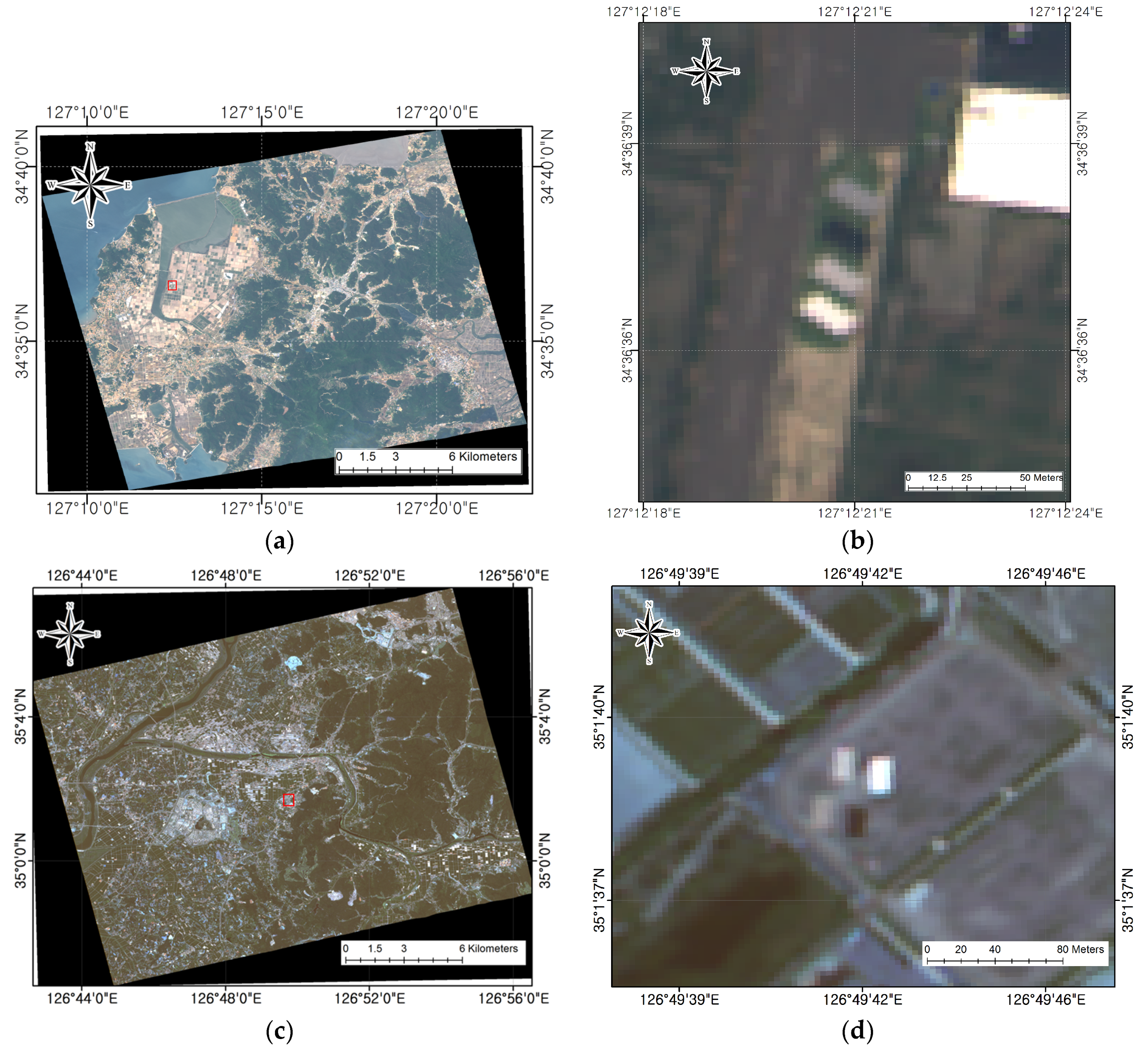
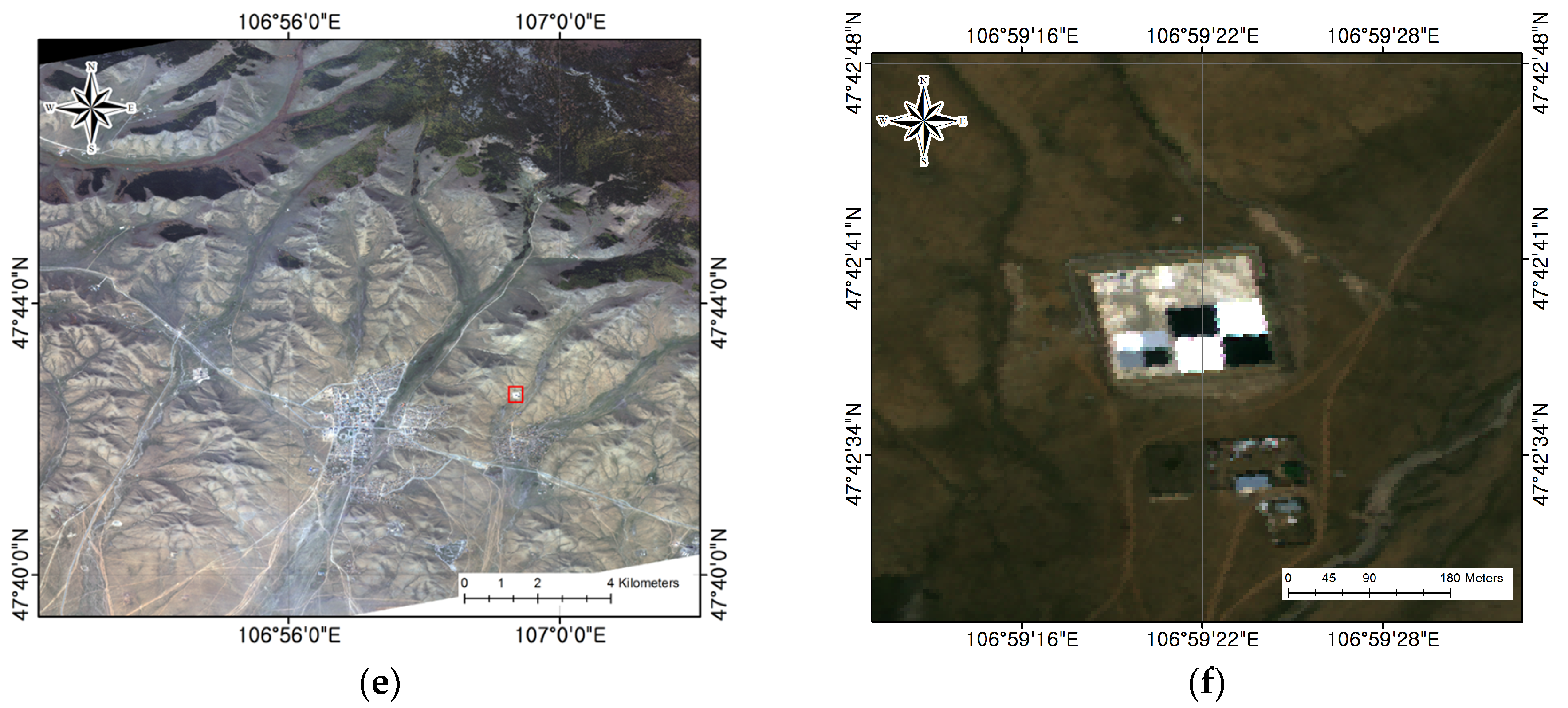


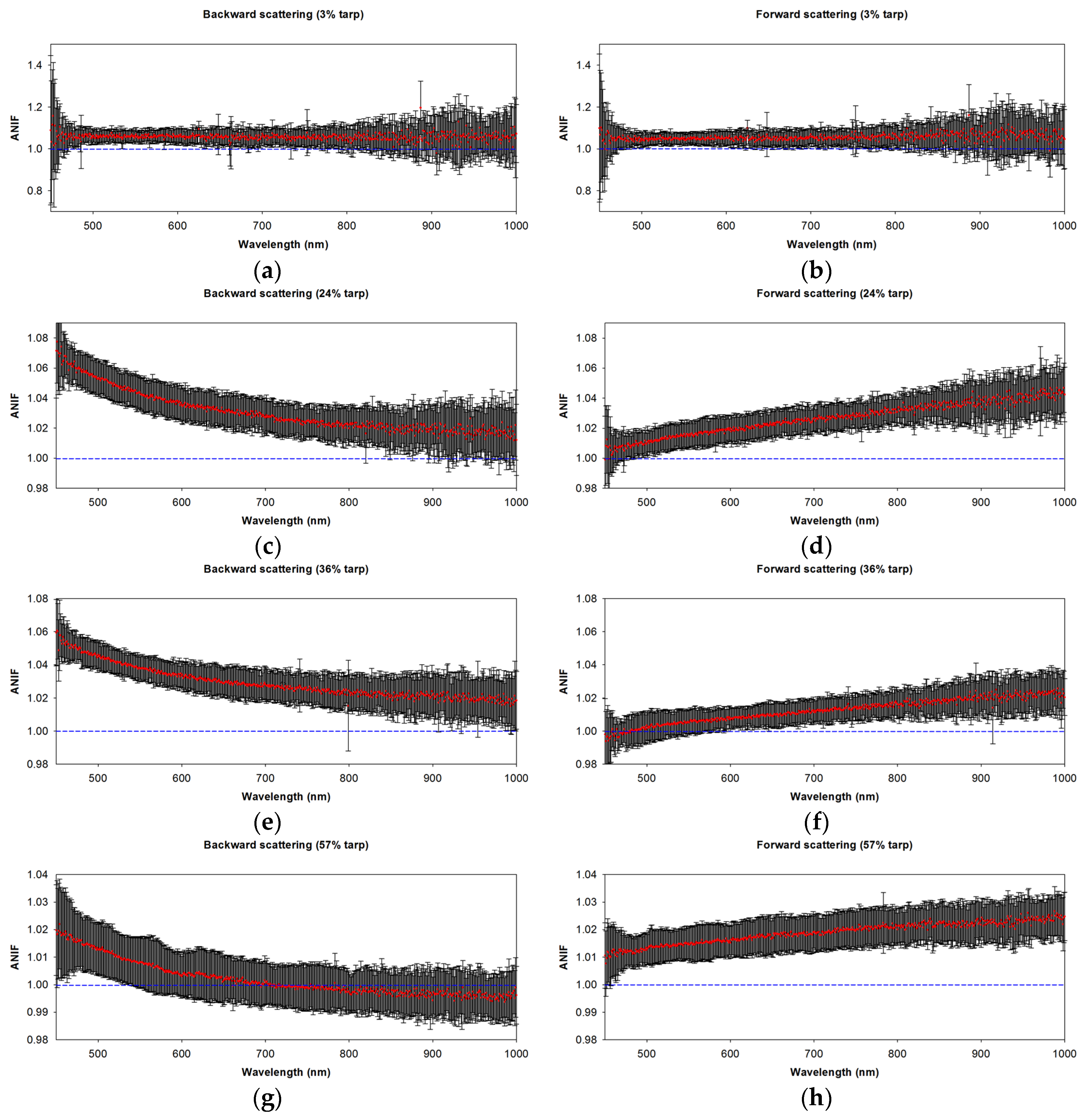
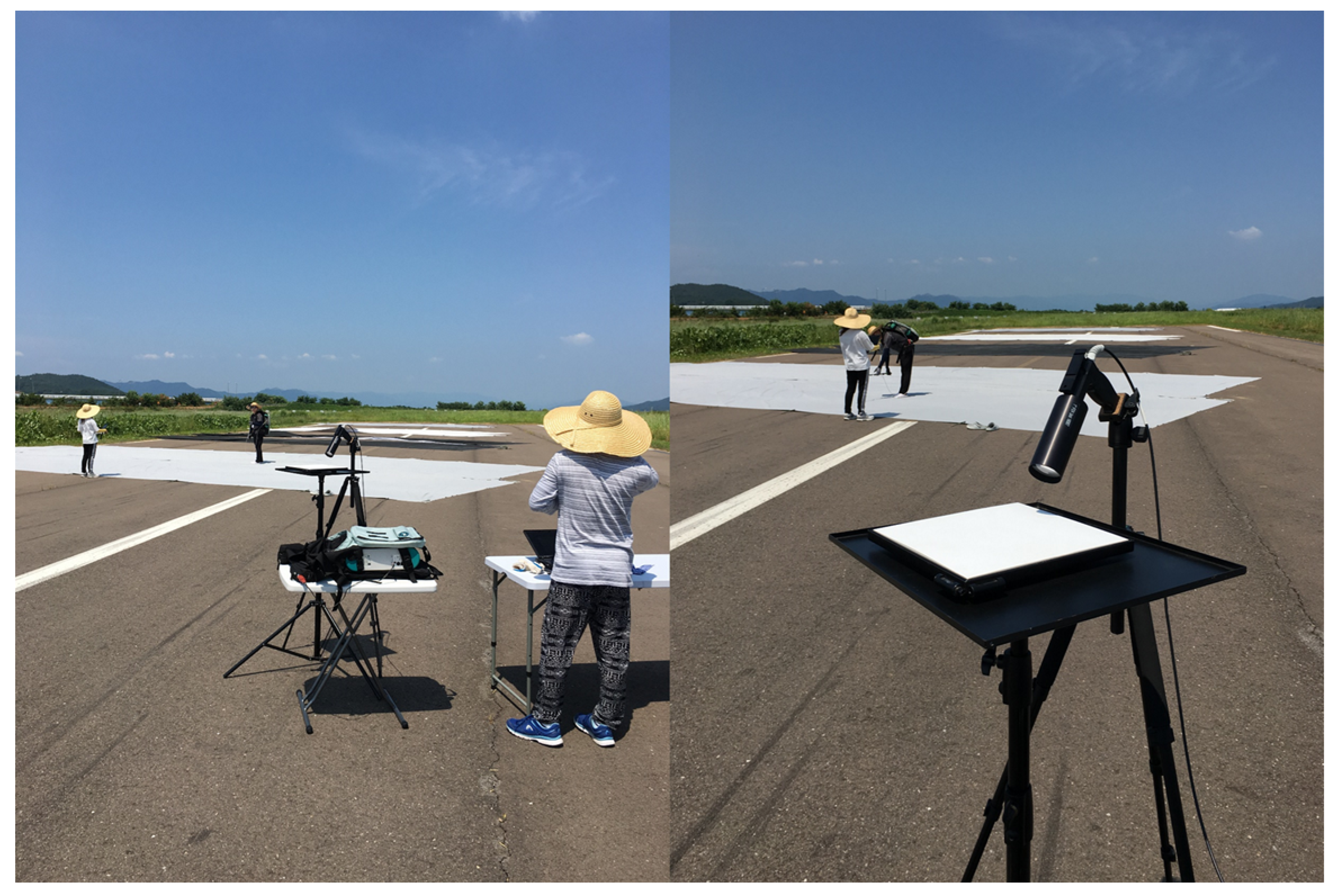
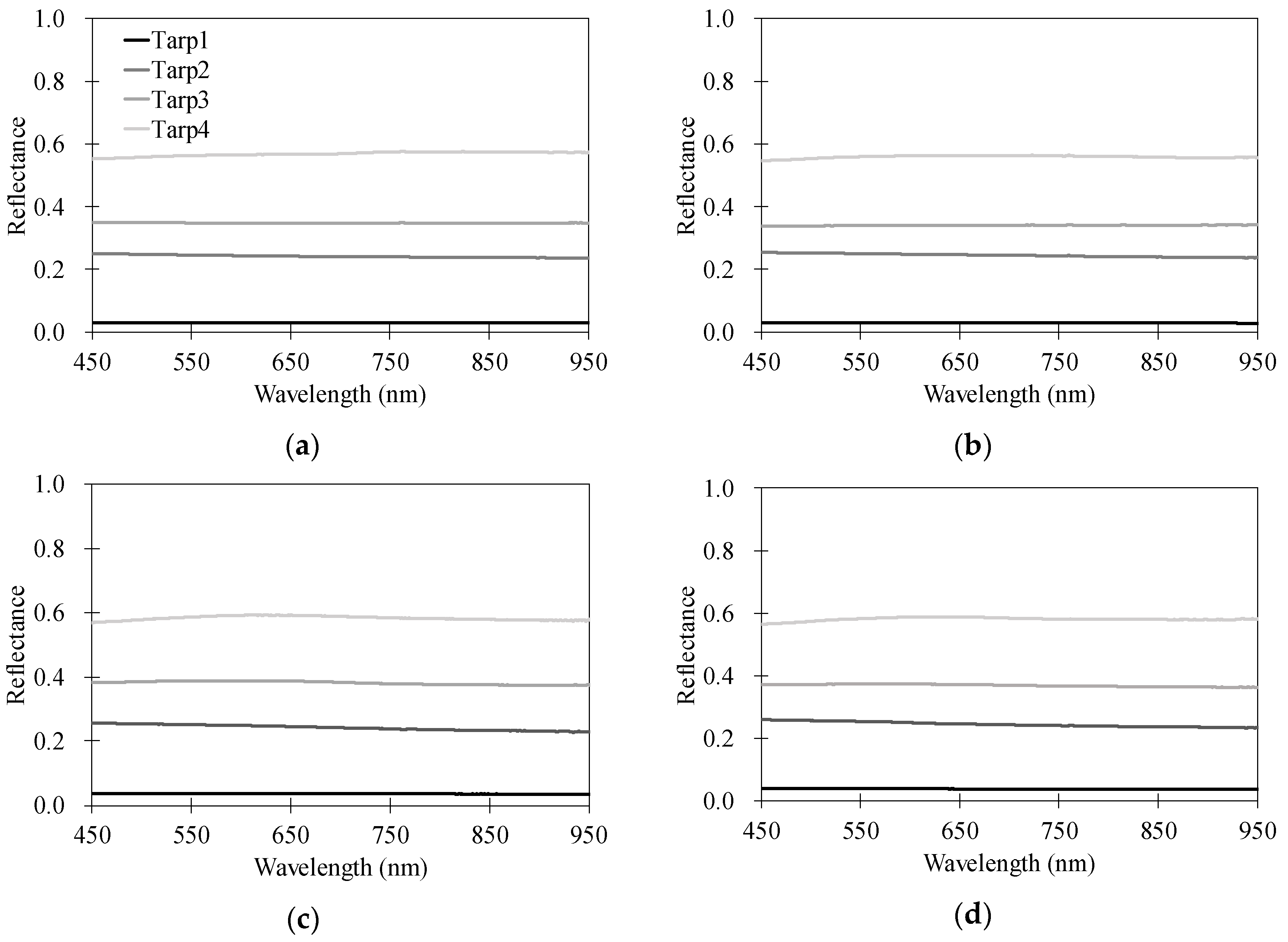
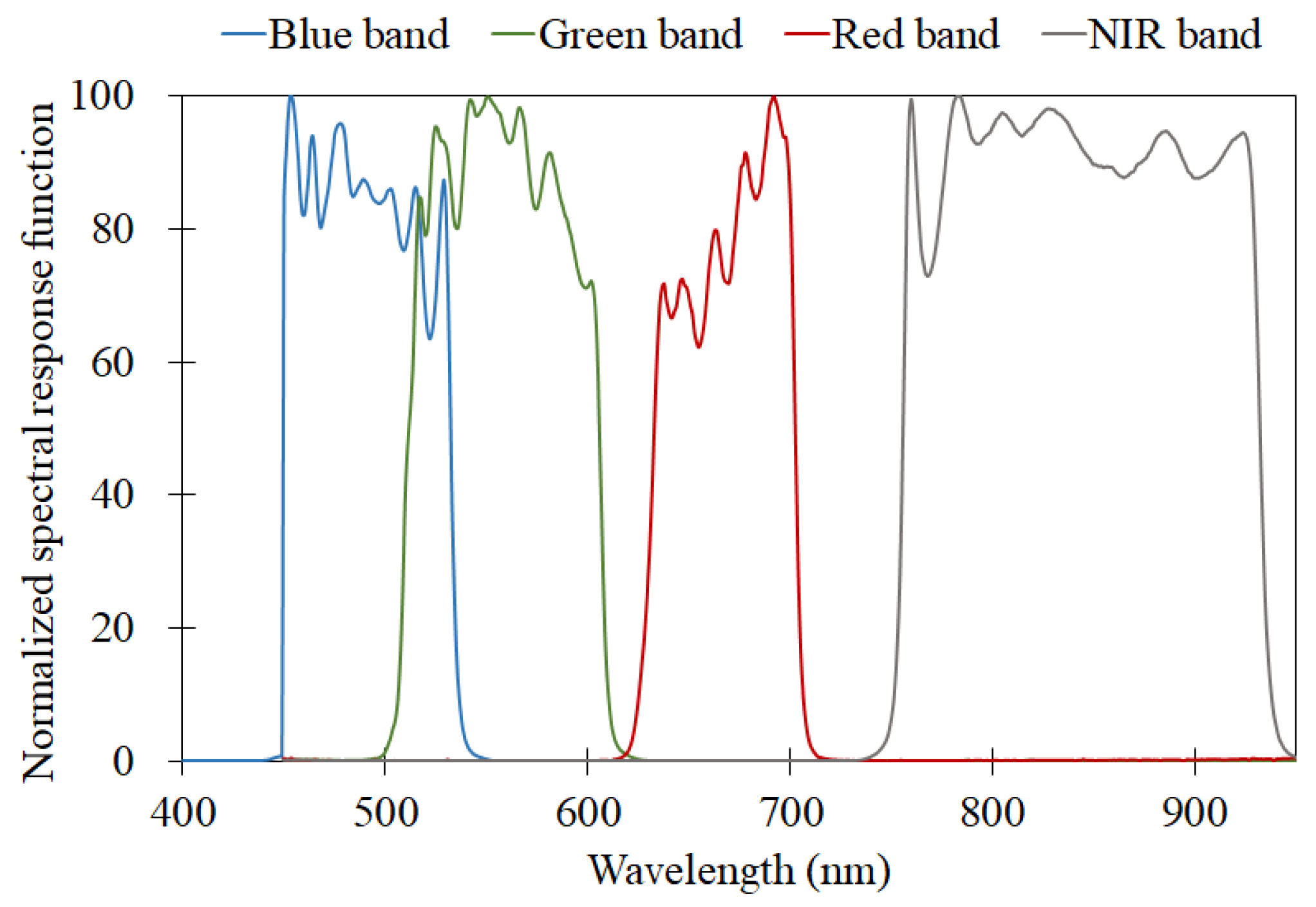
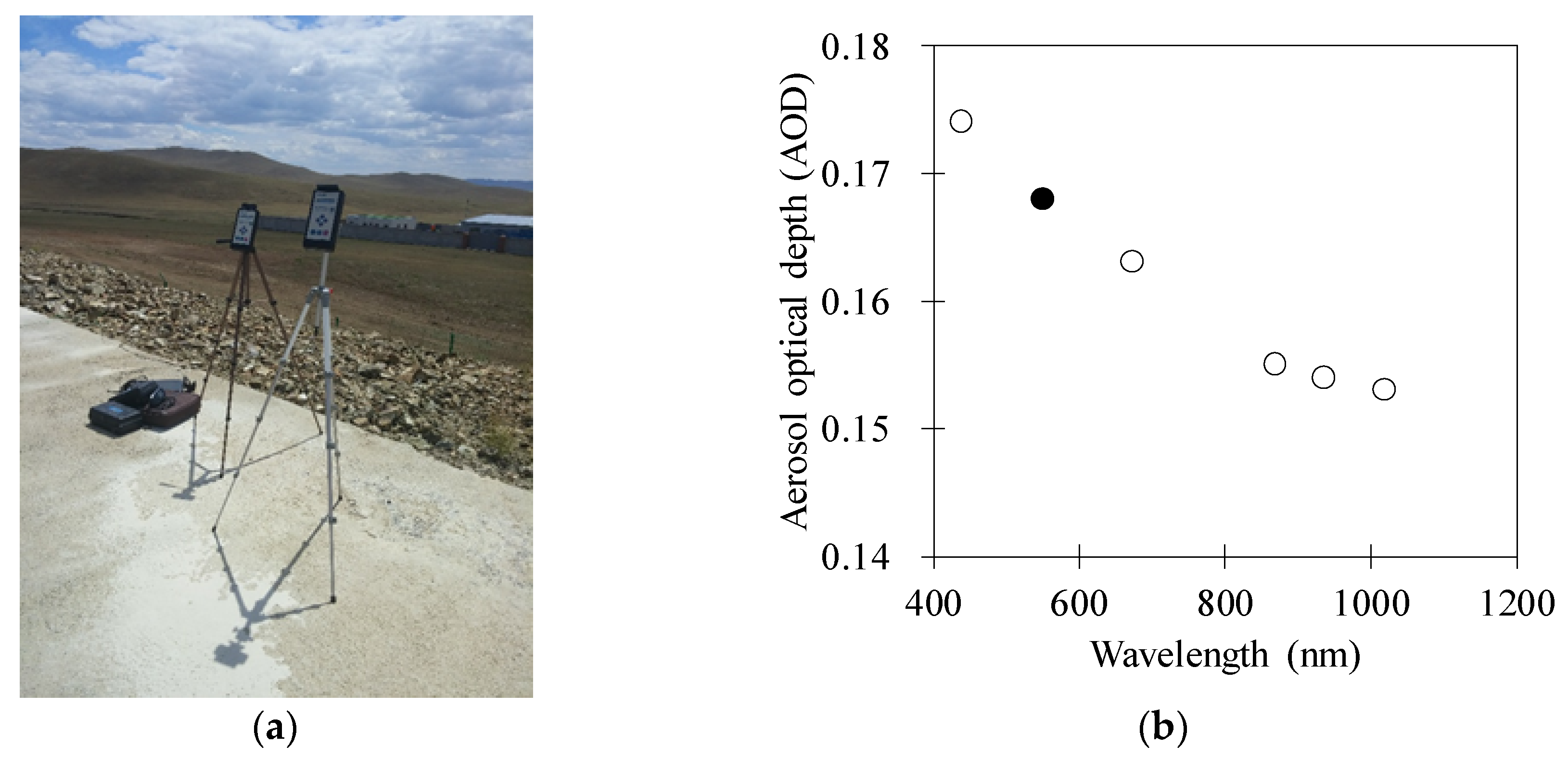
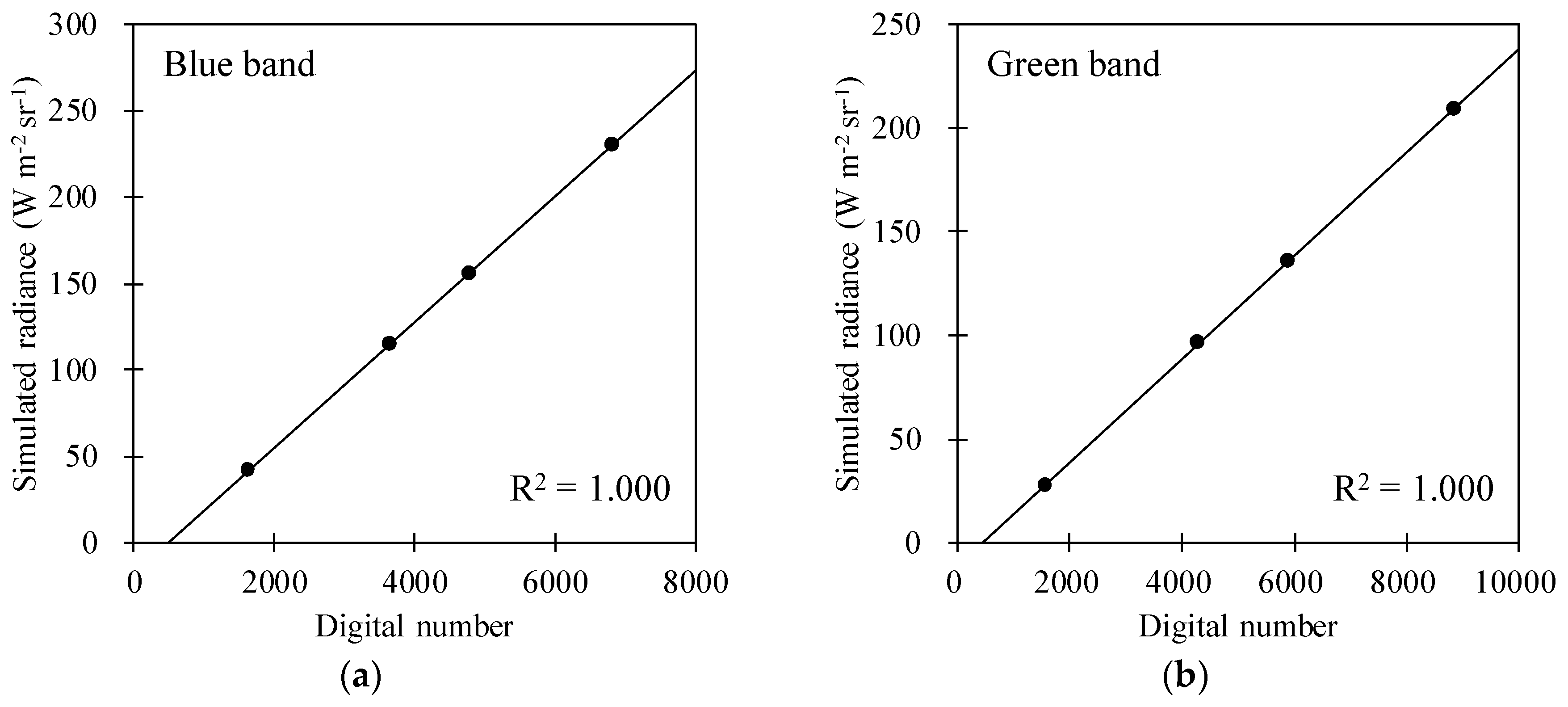
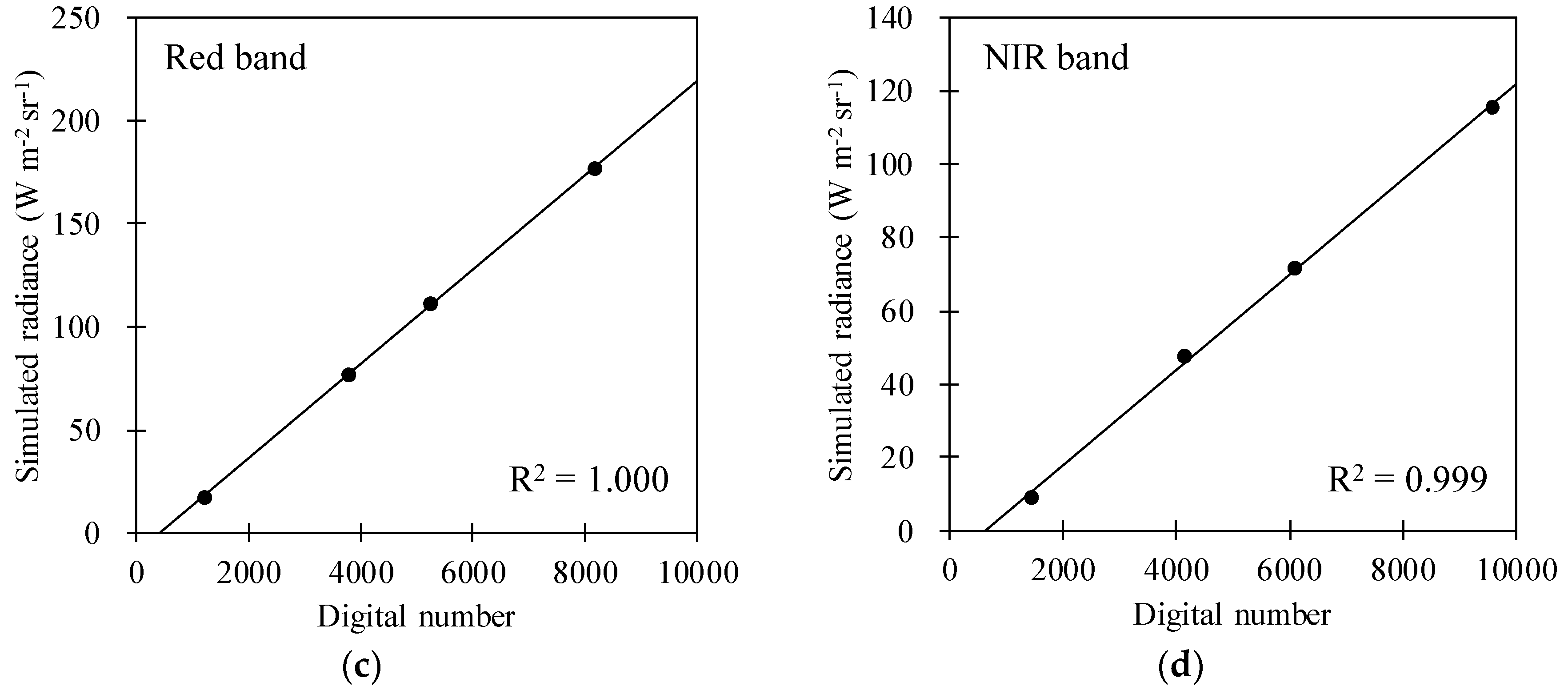
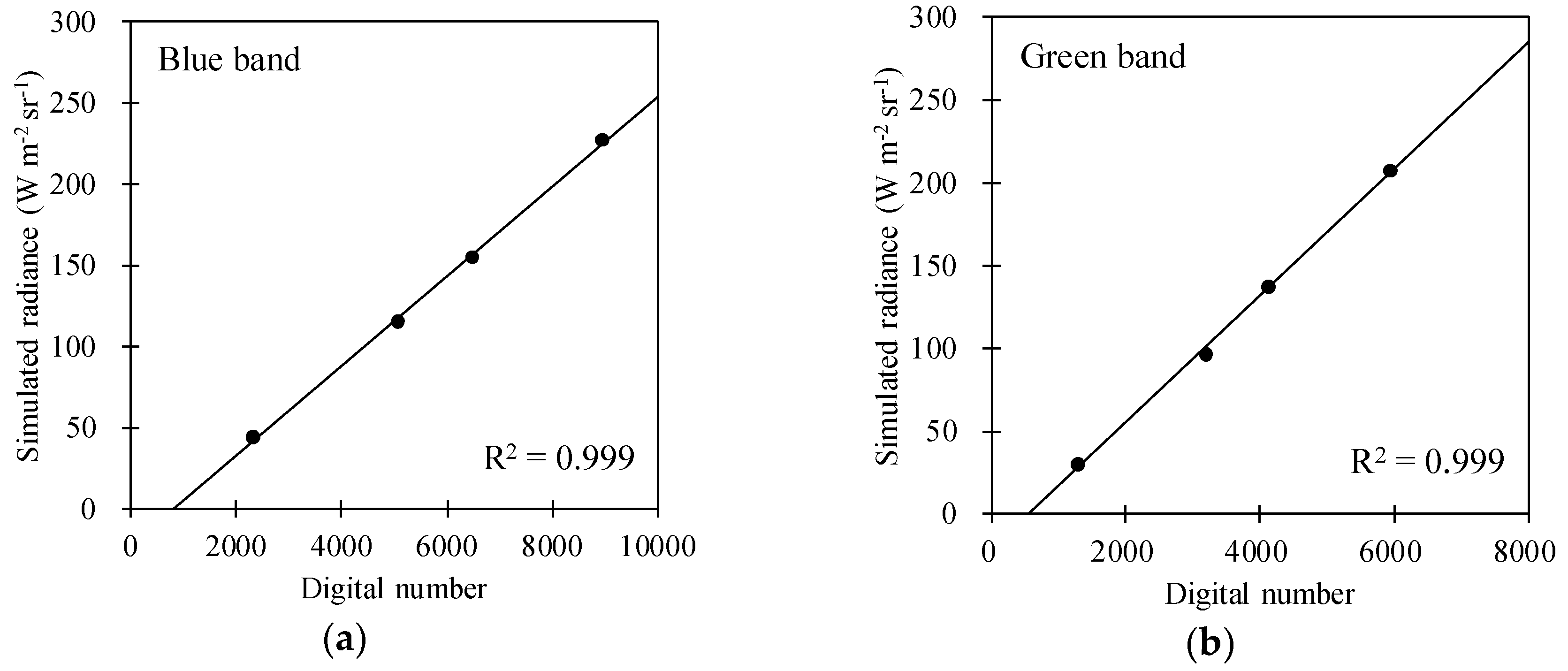
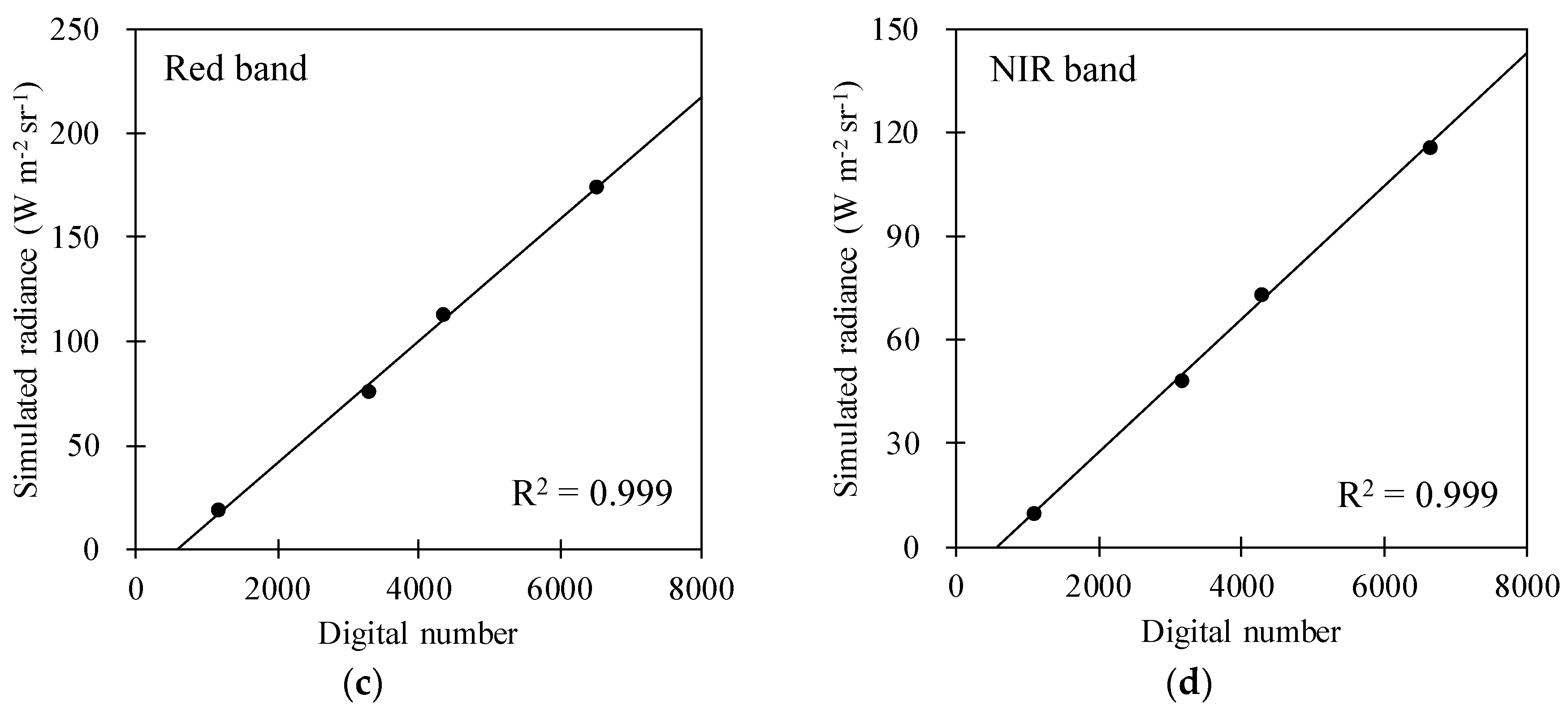
| Mission Characteristic | KOMPSAT-3 | KOMPSAT-3A |
|---|---|---|
| Design lifetime | 4 years | 4 years |
| Orbit altitude | 685 km | 528 km |
| Swath width | ≥15 km (at nadir) | ≥12 km (at nadir) |
| Ground sample distance | Pan: 0.7 m (altitude 685 km) MS: 2.8 m (altitude 685 km) | Pan: 0.55 m (altitude 528 km) MS: 2.2 m (altitude 528 km) IR: 5.5 m (altitude 528 km) |
| Spectral bands | Pan: 450–900 nm Blue: 450–520 nm Green: 520–600 nm Red: 630–690 nm NIR: 760–900 nm | Pan: 450–900 nm Blue: 450–520 nm Green: 520–600 nm Red: 630–690 nm NIR: 760–900 nm MWIR: 3300–5200 nm |
| Radiometric resolution | 14 bit | 14 bit |
| Modulation Transfer Function (MTF) | PAN ≥8% MS ≥12% | PAN ≥10% MS ≥13% |
| Signal-to-Noise Ratio (SNR) | >100 for Pan and MS | >100 for Pan and MS |
| Date | Satellite | Site | Observed Time (UTC) | Solar Zenith | Solar Azimuth | Viewing Zenith | Viewing Azimuth |
|---|---|---|---|---|---|---|---|
| 14 May 2017 | KOMPSAT-3 | Goheung | 04:27:16 | 28.500 | 242.883 | 17.202 | 140.507 |
| 27 July 2017 | KOMPSAT-3 | Naju | 04:34:59 | 20.091 | 221.489 | 21.833 | 184.074 |
| 19 September 2017 | KOMPSAT-3A | Zuunmod | 05:38:57 | 48.209 | 200.921 | 3.112 | 259.113 |
| 20 September 2017 | KOMPSAT-3 | Zuunmod | 05:47:39 | 48.040 | 197.588 | 0.762 | 257.866 |
| Date | Water Vapor (g cm−2) | Total Ozone (cm-atm) | Aerosol Optical Depth (550 nm) |
|---|---|---|---|
| 14 May 2017 | 0.997 | 0.350 | 0.207 |
| 27 July 2017 | 3.001 | 0.251 | 0.135 |
| 19 September 2017 | 0.569 | 0.297 | 0.055 |
| 20 September 2017 | 0.534 | 0.305 | 0.087 |
| Band | Scale Factor | |||
|---|---|---|---|---|
| KOMPSAT-3, 05/14 | KOMPSAT-3, 07/27 | KOMPSAT-3A, 09/19 | KOMPSAT-3, 09/20 | |
| Blue | 0.0256 (0.0260) 1 | 0.0239 | 0.0362 | 0.0275 |
| Green | 0.0359 (0.0365) 1 | 0.0309 | 0.0249 | 0.0382 |
| Red | 0.0259 (0.0265) 1 | 0.0230 | 0.0229 | 0.0294 |
| NIR | 0.0177 (0.0181) 1 | 0.0149 | 0.0130 | 0.0192 |
| Offset | ||||
| Blue | −47.8711 (−48.7996) 1 | −45.0553 | −22.1416 | −28.4989 |
| Green | −38.8875 (−40.5952) 1 | −24.9649 | −14.0210 | −27.3846 |
| Red | −21.5454 (−21.6730) 1 | −14.8416 | −13.0457 | −21.6854 |
| NIR | −20.5972 (−20.2303) 1 | −14.2401 | −10.2834 | −13.5910 |
| Bands | KOMPSAT-3 | KOMPSAT-3A | ||
|---|---|---|---|---|
| Previous | Updated | Previous | Updated | |
| Blue | 0.0185 | 0.0275 | 0.0301 | 0.0362 |
| Green | 0.0248 | 0.0382 | 0.0438 | 0.0249 |
| Red | 0.0214 | 0.0294 | 0.0443 | 0.0229 |
| NIR | 0.0141 | 0.0192 | 0.0235 | 0.0130 |
| Factors | Radiance Error (%) | |
|---|---|---|
| KOMPSAT-3 | KOMPSAT-3A | |
| Relative radiometric correction | 5 | 5 |
| Solar irradiance data | 1 | 1 |
| Laboratory-based BRDF measurements | <1 | <1 |
| Surface reflectance measurement | 1 | 1 |
| ASD FieldSpec® 3 instrument | <1 | <1 |
| 6S Radiative transfer | 1 | 1 |
| AOD from Microtops II® Sunphotometer | <1 | <1 |
| Total ozone from Microtops II® Ozonometer | <1 | <1 |
| Column water vapor from Microtops II® Sunphotometer | <1 | <1 |
| Combined error | ~5.7 | ~5.7 |
© 2018 by the authors. Licensee MDPI, Basel, Switzerland. This article is an open access article distributed under the terms and conditions of the Creative Commons Attribution (CC BY) license (http://creativecommons.org/licenses/by/4.0/).
Share and Cite
Yeom, J.-M.; Ko, J.; Hwang, J.; Lee, C.-S.; Choi, C.-U.; Jeong, S. Updating Absolute Radiometric Characteristics for KOMPSAT-3 and KOMPSAT-3A Multispectral Imaging Sensors Using Well-Characterized Pseudo-Invariant Tarps and Microtops II. Remote Sens. 2018, 10, 697. https://doi.org/10.3390/rs10050697
Yeom J-M, Ko J, Hwang J, Lee C-S, Choi C-U, Jeong S. Updating Absolute Radiometric Characteristics for KOMPSAT-3 and KOMPSAT-3A Multispectral Imaging Sensors Using Well-Characterized Pseudo-Invariant Tarps and Microtops II. Remote Sensing. 2018; 10(5):697. https://doi.org/10.3390/rs10050697
Chicago/Turabian StyleYeom, Jong-Min, Jonghan Ko, Jisoo Hwang, Chang-Suk Lee, Chul-Uong Choi, and Seungtaek Jeong. 2018. "Updating Absolute Radiometric Characteristics for KOMPSAT-3 and KOMPSAT-3A Multispectral Imaging Sensors Using Well-Characterized Pseudo-Invariant Tarps and Microtops II" Remote Sensing 10, no. 5: 697. https://doi.org/10.3390/rs10050697
APA StyleYeom, J.-M., Ko, J., Hwang, J., Lee, C.-S., Choi, C.-U., & Jeong, S. (2018). Updating Absolute Radiometric Characteristics for KOMPSAT-3 and KOMPSAT-3A Multispectral Imaging Sensors Using Well-Characterized Pseudo-Invariant Tarps and Microtops II. Remote Sensing, 10(5), 697. https://doi.org/10.3390/rs10050697








